Proposed classification for the transbasal approach and its modifications
- PMID: 18592024
- PMCID: PMC2435472
- DOI: 10.1055/s-2007-994292
Proposed classification for the transbasal approach and its modifications
Abstract
The transbasal approach offers extradural exposure of the anterior midline skull base transcranially. It can be used to treat a variety of conditions, including trauma, craniofacial deformity, and tumors. This approach has been modified to enhance basal access. This article reviews the principle differences among modifications to the transbasal approach and introduces a new classification scheme. The rationale is to offer a uniform nomenclature to facilitate discussion of these approaches, their indications, and related issues.
Keywords: Frontal fossa; skull base; subcranial; subfrontal; transbasal.
Figures
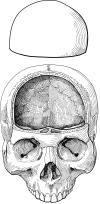
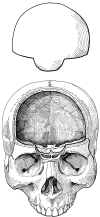



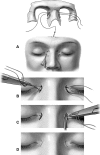



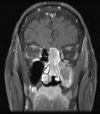

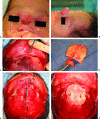



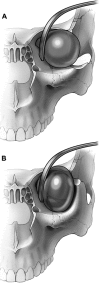




Similar articles
-
Anatomical Step-by-Step Dissection of Complex Skull Base Approaches for Trainees: Surgical Anatomy of the Bifrontal Transbasal Approach, Surgical Principles, and Illustrative Cases.J Neurol Surg B Skull Base. 2023 Oct 9;85(6):596-605. doi: 10.1055/s-0043-1775875. eCollection 2024 Dec. J Neurol Surg B Skull Base. 2023. PMID: 39483163 Free PMC article.
-
The radical transbasal approach for resection of anterior and midline skull base lesions.J Neurosurg. 2005 Sep;103(3):485-90. doi: 10.3171/jns.2005.103.3.0485. J Neurosurg. 2005. PMID: 16235681
-
The extended transbasal approach: a quantitative anatomical and histological study.Acta Neurochir (Wien). 1999;141(3):251-9. doi: 10.1007/s007010050295. Acta Neurochir (Wien). 1999. PMID: 10214481
-
Extended transbasal approach to skull base tumors. Technical nuances and review of the literature.Oncology (Williston Park). 2005 Jun;19(7):913-9; discussion 920, 923-5, 929. Oncology (Williston Park). 2005. PMID: 16053038 Review.
-
Combined Endoscopic and Open Approaches in the Management of Sinonasal and Ventral Skull Base Malignancies.Otolaryngol Clin North Am. 2017 Apr;50(2):331-346. doi: 10.1016/j.otc.2016.12.009. Otolaryngol Clin North Am. 2017. PMID: 28314401 Review.
Cited by
-
The interhemispheric fissure-surgical outcome of interhemispheric approaches.Neurosurg Rev. 2021 Aug;44(4):2099-2110. doi: 10.1007/s10143-020-01372-6. Epub 2020 Aug 27. Neurosurg Rev. 2021. PMID: 32852637 Free PMC article.
-
Combined craniofacial resection of anterior skull base tumors: long-term results and experience of single institution.Neurosurg Rev. 2011 Jan;34(1):101-13. doi: 10.1007/s10143-010-0286-1. Epub 2010 Sep 29. Neurosurg Rev. 2011. PMID: 20878534
-
Midline Meningiomas of the Anterior Skull Base: Surgical Outcomes and a Decision-Making Algorithm for Classic Skull Base Approaches.Cancers (Basel). 2020 Nov 3;12(11):3243. doi: 10.3390/cancers12113243. Cancers (Basel). 2020. PMID: 33153110 Free PMC article.
-
The transbasal approach to the anterior skull base: surgical outcome of a single-centre case series.Sci Rep. 2020 Dec 31;10(1):22444. doi: 10.1038/s41598-020-80255-8. Sci Rep. 2020. PMID: 33384441 Free PMC article.
-
Clinicopathological features of cranial-nasal-orbital communicating lesions and diagnostic indicators for differentiating benign and malignant neoplasms.Int J Ophthalmol. 2025 Jul 18;18(7):1357-1368. doi: 10.18240/ijo.2025.07.20. eCollection 2025. Int J Ophthalmol. 2025. PMID: 40688786 Free PMC article.
References
-
- Beals S P, Joganic E. Transfacial exposure of anterior cranial fossa and clival tumors. BNI Q. 1992;8:2–18.
-
- Raso J L, Gusmäo S. Transbasal approach to skull base tumors: evaluation and proposal of classification. Surg Neurol. 2006;65(suppl 1):S1:33–S1:37. discussion 1:37–1:38. - PubMed
-
- Dandy W E. Orbital Tumors: Results Following the Transcranial Operative Attack. New York: Oskar Piest; 1941.
-
- Unterberger S. Care of frontobasal wounds [in German] Arch Ohren Nasen Kehlkopfheilkd. 1958;172:463–484. - PubMed
-
- Tessier P, Guiot G, Derome P. Orbital hypertelorism: II. Definite treatment of orbital hypertelorism (OR.H.) by craniofacial or by extracranial osteotomies. Scand J Plast Reconstr Surg. 1973;7:39–58. - PubMed

